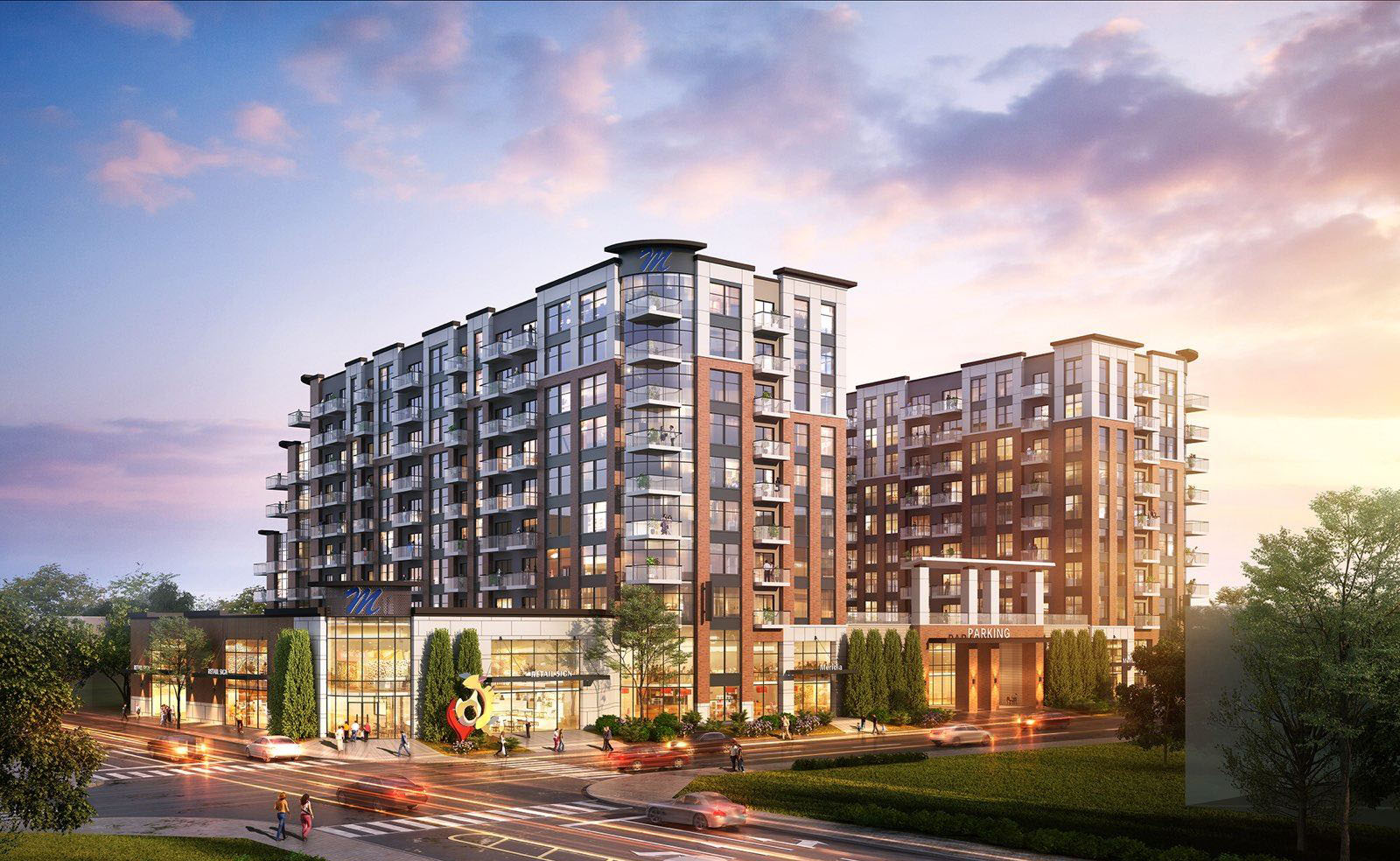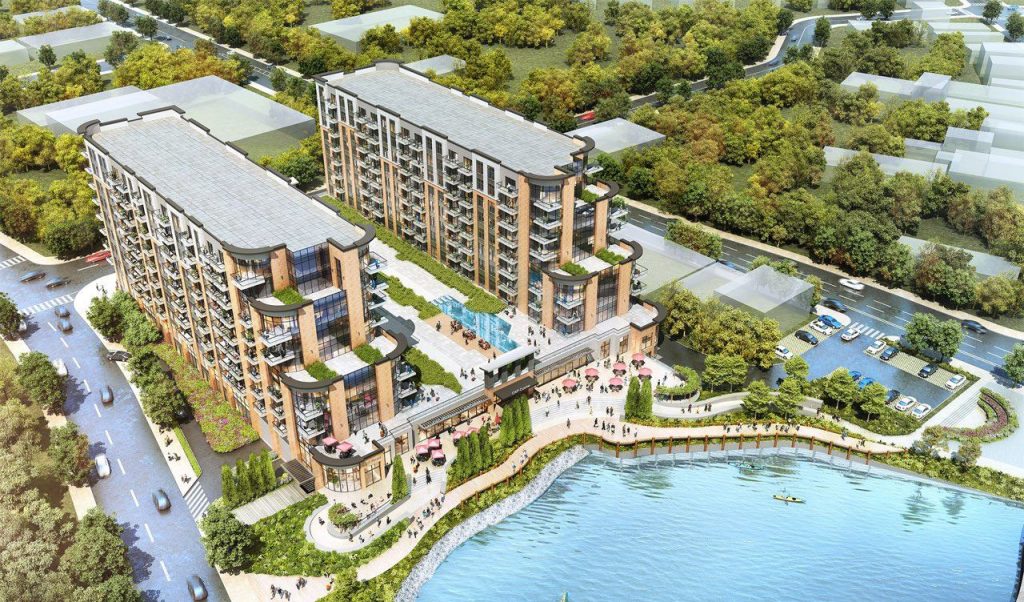
A proposed mixed-use redevelopment project proposed for Water Street in downtown Toms River. (Photo: Toms River Township)
The first, large-scale project to redevelop downtown Toms River took a step forward with Township Council approving a financial agreement with the developer for a 10-story building.
The 285-unit, two-tower apartment building would have basement level parking, ground level commercial businesses, followed by studio apartments and one, two and three bedroom units in the riverfront spot where the Red Carpet Inn once was, including an area of West Water, Main and Irons streets downtown.
The debate and questions about the project drew more than a dozen residents and business owners to a township council meeting Tuesday night. At first, Councilman Terrance Turnbach asked that the ordinance be tabled, saying he had been contacted by residents concerned the financial agreement was released publicly only shortly before the meeting. Instead, Turnbach said, the ordinance could be tabled until the first September meeting, allowing for two more weeks of dissemination of the information, a 220-plus page document that spells out the Payment In Lieu of Taxes and other financial particulars of Toms River’s first high-rise residential building. Councilman Dan Rodrick supported tabling the ordinance, but the five other council members voted against tabling.
Passionate comments from longtime residents, downtown business owners, parents and representatives from the Toms River Business Improvement District created a two-and-a-half hour discussion. Sticking points included the Payment in Lieu of Taxes, or PILOT, part of the financial agreement for redeveloper Capodagli Group.
The plan would see Capodagli acquiring one parcel of land required for the project – owned by the Toms River Parking Authority – for $560,000. The former motel property would be sold to the company for $1. The motel property was purchased by taxpayers for $3.3 million. Though the value of the property is expected to be assessed in the tens of millions of dollars, Capodagli would be responsible for just $392,747 in tax obligations each year under a payment in lieu of taxes, or PILOT, plan. Commonly known as a tax abatement, PILOTs are normally used to lure developers to blighted properties that would not otherwise garner investment.
Councilwoman Maria Maruca said the current plan was not the first one the redeveloper presented. “The first one was too large, it had too many units, so they reworked the plan and presented something better,” she said, referencing redevelopment attorney Joseph Baumann, who represents the township in this project.
Baumann, and Township Planner Dave Roberts were on hand at the meeting to answer public questions about the project. Amid the discussion, a concern of whether the PILOT would help cover a school tax burden revealed that part of the agreement had not been reached.
Public comments weighed in on the question of “what downtown Toms River needs,” with some residents expressing the building would have a negative impact to the character, traffic and parking downtown, and that in other ways it could increase demands on schools and other services such as emergency response.
“This is not a good deal for Toms River, and not a good deal for Toms River Schools,” said Councilman Daniel Rodrick.
Others, such as Alizar Zorojew, who is a longtime downtown resident and serves on the Toms River Business Improvement District, said the 10-story building will be positive for Toms River.
“This project will be a catalyst, and bring an identity to the riverfront,” he said.

A proposed mixed-use redevelopment project proposed for Water Street in downtown Toms River. (Photo: Toms River Township)
More public comments from the business community shared their support of the project, with Mairin Bellack, executive director of the Downtown Toms River Business Improvement District, saying she had forwarded many letters of support to the council from its member businesses.
Councilman Matt Lotano said though the vote was for the financial agreement and transfer of one building project, it was a step toward voting for the future of the downtown. “There’s a lot of abstract things at play here. What will the impact be five years, 10 years, 30 years down the road?,” Lotano said. “We all agree something has to happen downtown — what is it?”
Still others, including many business owners, said this area needs residential units to support efforts for a thriving downtown. The Capodagli project would be the first major project in the redevelopment of downtown Toms River, which includes plans to add other amenities, multi-story mixed-use buildings, and community art and entertainment spaces.
One business owner, Frank Davis, shared concerns that a lack of parking is already deterring his customers, and the logistics of the 10-story building and its dedicated two-floor parking garage for its residents would not necessarily help, especially when considering the closure of streets and detours in place for construction, as well as state grants to reconfigure roads downtown.
James Citta, longtime resident and retired judge, said the project was the latest in a history of downtown efforts to revitalize the area. Whether drawing comparisons to the Urban Renewal of the 1970s, and how historic buildings were leveled then, to more recent efforts to create a Village Seaport and a Business Improvement District, Citta said the council was acting without pausing to ask the public its thoughts, and that often plans change from what was first presented to what it becomes. “Legion Square was supposed to have business on the first floor,” said Citta, referring to the newest residential building downtown, the 5-story apartments across from High School South.
At the end of public comment, Turnbach again asked for the council to table the ordinance until the next council meeting, which had support from Rodrick, but failed. The council voted to approve the ordinance, with Turnbach and Rodrick voting ‘no’ with Councilpersons Maruca, Lotano, Kevin Geoghegan, Josh Kopp and Laurie Huryk voting ‘yes.’
After the vote, members of the audience as well as the council suggested more public discussion and input should be cultivated on the downtown redevelopment. Suggestions included forming a redevelopment committee, devoting social media campaigns, and making redevelopment info more obvious on the township website.
“Change has got to happen,” said Council President Geoghegan. “I think there’s going to be a lot of opportunity to have discussion on what that change should be.”


Police, Fire & Courts
Toms River Man Sentenced to Prison for Assault, Eluding, Robbery, Threats







